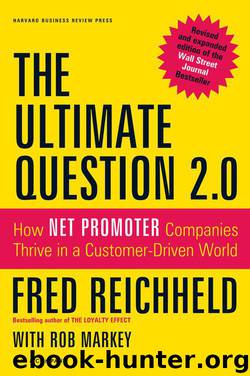The Ultimate Question 2.0: How Net Promoter Companies Thrive in a Customer-Driven World by Reichheld Fred & Markey Rob

Author:Reichheld, Fred & Markey, Rob [Markey, Rob]
Language: eng
Format: epub
ISBN: 9781422173350
Publisher: Harvard Business Press
Published: 2011-09-19T14:00:00+00:00
The Progressive Group of Insurance Companies
One thing we noticed as we watched NPS spread was that companies were learning from each other. Progressive, for instance, is one of Enterprise Rent-A-Car’s largest customers. Progressive CEO Glenn Renwick had long admired Enterprise’s commitment to earning customer loyalty, and he knew Enterprise well enough to understand the important role of customer feedback. That helped convince him he should adopt Net Promoter at Progressive.
Renwick had an urgent economic reason as well. Progressive had carefully quantified the financial impact of customer retention, or “persistency,” as it is known in the industry. Increasing average policy length by just one month would increase premiums over the life of all policies by more than $1 billion—an impressive amount even to a company such as Progressive, a large U.S. property and casualty insurer with more than $14 billion in premiums.
But how to encourage loyalty? In the past, says Renwick, efforts aimed at being “nice and supportive” to customers never really took a deep enough view of customer retention. “We had a strong analytical side, but we had trouble embracing things that were soft.” NPS, with its rigorous numbers-oriented methodology, helped bridge that gap. “NPS could be an analytical measure that to us could be equivalent to the power of ‘loss ratio,’” Renwick says. “It creates a measure of customer relationship health that is as analytically powerful and actionable as our other hard metrics.
“The beauty of NPS,” he adds, “is that it’s a common language—you don’t have to reinterpret it to the different people you’re talking to. We can go to the most analytical people in the organization and ask them the NPS of everyone who had a claim serviced in Florida. They could understand this and act on it.”
Renwick began to talk about Net Promoter to employees, his board, and investors. He included progress reports on NPS in the company’s annual report. Asked about the most effective tactic for winning acceptance, he explained that he, as CEO, could insist on including NPS as one of the company’s key metrics, and he could demonstrate a direct link between NPS and retention and therefore profits. But what really drove acceptance was when the most independent and hard-nosed department in his operation put NPS to the test—and liked what they saw. “Our claims operation was among the first on board. Once they adopted it, it validated NPS for the rest of the organization, because they are a no-nonsense, pragmatic, and results-driven group.”
It also didn’t hurt that Renwick assigned a direct report, Richard Watts, to become the executive sponsor of the NPS initiative. Watts was group president of sales and service. With six call centers and about nine thousand full-time-equivalent employees under him, he was responsible for more than 60 million customer interactions and the overall customer experience. Watts, though he had grown up in the firm’s numbers-driven culture, believed that NPS could help get the company more customer-focused. But he also saw that it would take work.
An early initiative, for example, was to search out policies and procedures that were creating detractors.
Download
This site does not store any files on its server. We only index and link to content provided by other sites. Please contact the content providers to delete copyright contents if any and email us, we'll remove relevant links or contents immediately.
Bad Blood by John Carreyrou(6274)
Rich Dad Poor Dad by Robert T. Kiyosaki(6174)
Principles: Life and Work by Ray Dalio(5961)
Playing to Win_ How Strategy Really Works by A.G. Lafley & Roger L. Martin(5499)
Management Strategies for the Cloud Revolution: How Cloud Computing Is Transforming Business and Why You Can't Afford to Be Left Behind by Charles Babcock(4438)
The Confidence Code by Katty Kay(4037)
Thinking in Bets by Annie Duke(3996)
American Kingpin by Nick Bilton(3507)
Delivering Happiness by Tony Hsieh(3280)
Project Animal Farm: An Accidental Journey into the Secret World of Farming and the Truth About Our Food by Sonia Faruqi(3018)
The Power of Habit by Charles Duhigg(2966)
Brotopia by Emily Chang(2893)
Mastering Bitcoin: Programming the Open Blockchain by Andreas M. Antonopoulos(2891)
The Tyranny of Metrics by Jerry Z. Muller(2846)
I Live in the Future & Here's How It Works by Nick Bilton(2844)
The Marketing Plan Handbook: Develop Big-Picture Marketing Plans for Pennies on the Dollar by Robert W. Bly(2793)
The Content Trap by Bharat Anand(2778)
Building a StoryBrand by Donald Miller(2754)
Applied Empathy by Michael Ventura(2749)
